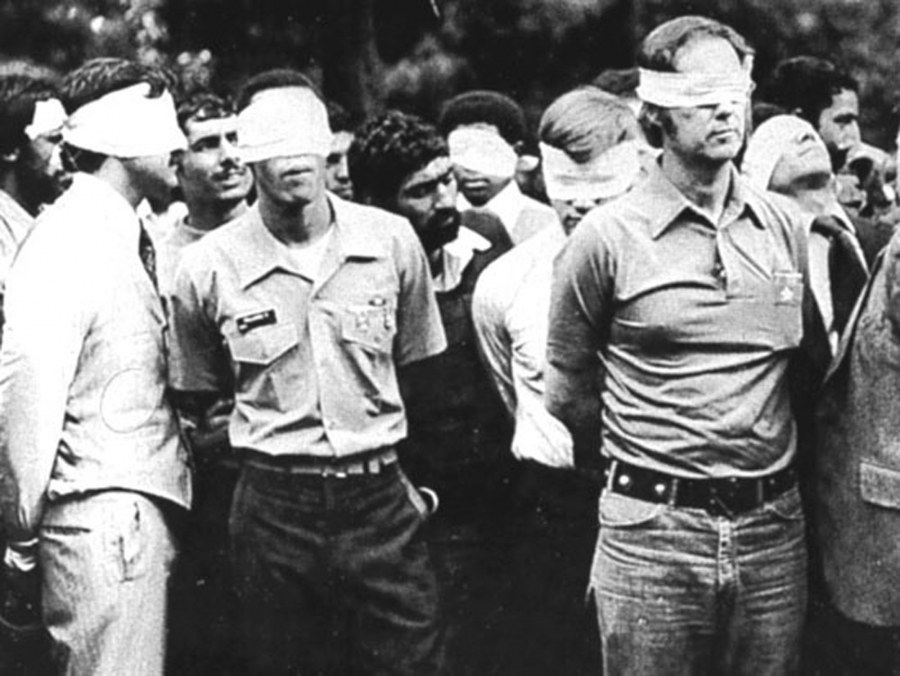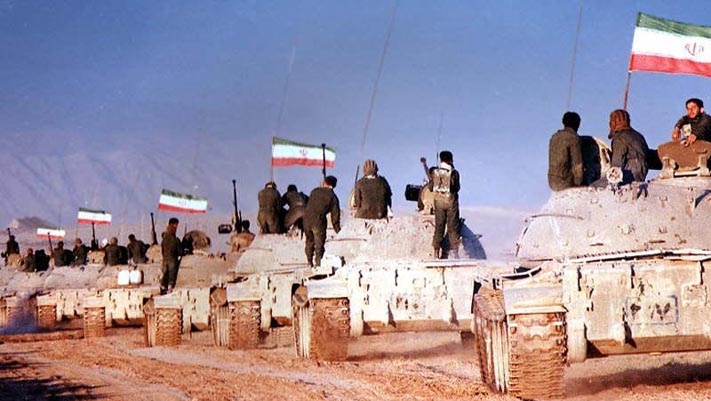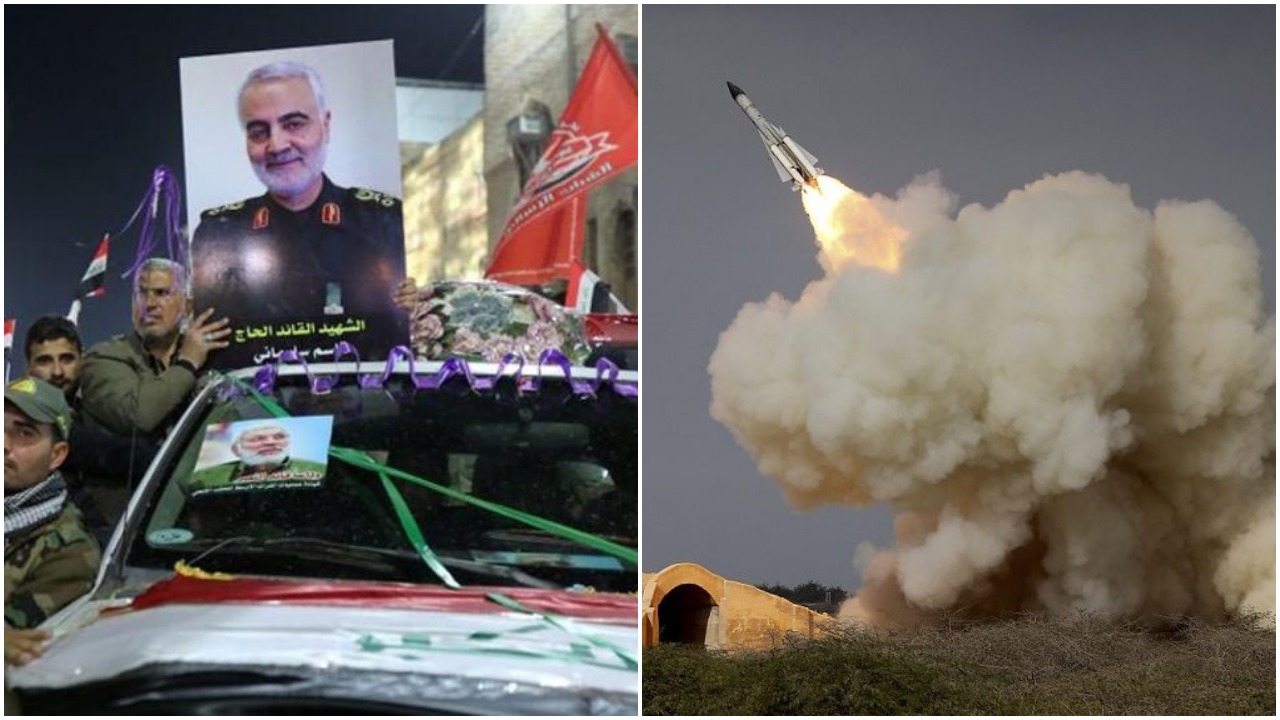TEHRAN: The US assassination of Iran’s top general, Qasem Soleimani, has escalated a “shadow war” in the Middle East between the US and Iran.
Soleimani was killed in a targeted, Jan. 3 airstrike near Baghdad International Airport in Iraq. His death has brought about massive demonstrations against the US and a warning that Iran will retaliate.
“God the Almighty has promised to take martyr Soleimani’s revenge,” Gen. Esmail Ghaani, Soleimani’s successor as commander of the Quds Force, told Iranian state television. “Certainly, actions will be taken.”
US President Donald Trump authorized the airstrike against Soleimani without congressional approval, citing “imminent and sinister attacks.”
This escalation doesn’t come without a backstory. The US-Iran relationship has faced many ups and downs over the past century. More recent tensions have risen after Trump walked away from the Iran nuclear deal and reimposed crippling sanctions on the country in 2018. The United States has also grown increasingly concerned about Iran’s influence in Iraq, the government of which has faced months of popular protest.
Jan. 7: Iran fires rockets at Iraqi airbase hosting US forces
Rockets are fired at Iraq’s al Asad airbase, which hosts US forces, a US official tells Reuters, speaking on condition of anonymity. The official says there is no immediate information on any damage or casualties.
At least 56 people are killed in a stampede as tens of thousands of mourners pack streets for the funeral of a slain Iranian military commander in his hometown of Kerman, forcing his burial to be delayed by several hours, according to Iranian state media.
Jan. 6: Soleimani funeral procession draws massive crowds

A funeral ceremony for Soleimani is held amid a massive outpouring of grief and anger in Iran. The scale of the crowds, shown on television clogging major streets, is the biggest since the 1989 funeral for the founder of the Islamic Republic, Ayatollah Ruhollah Khomeini, leader of the 1979 Iranian Revolution. Crowds chant “Death to America.”
Jan. 5: Direct retaliation threatened, Iraq moves to order out troops
Maj. Gen. Hossein Dehghan — military adviser to Iran’s supreme leader, Ayatollah Ali Khamenei — tells CNN Iran will retaliate against US military targets.
Jan. 4: Cultural sites threatened
The White House formally notifies Congress of the strike against Soleimani. According to the War Powers Act of 1973, Congress must be informed within 48 hours of such an introduction of US forces abroad without a declaration of war or congressional approval. The entire notification is classified, prompting criticism from Pelosi.
Jan. 3: Commander killed, troops readied
US President Donald Trump Authorizes an overnight airstrike that kills Iranian Gen. Qasem Soleimani without congressional approval. “We took action last night to stop a war. We did not take action to start a war,” Trump said in a statement following the attack.
Jan. 2: Defense Department warning
US Defense Secretary Mark Esper warns the US may take preemptive action to protect American lives from expected attacks by Iran-backed militias.
Jan. 1: Withdrawal from the embassy
Iran-backed paramilitary groups, who have been protesting for a second day at the US Embassy in Iraq, tell their supporters to withdraw from the perimeter of the compound in Baghdad.
Dec. 31: Attack on US Embassy in Iraq
Iranian-backed militiamen launch an attack on the American Embassy in Baghdad. The embassy’s outer perimeter is stormed by demonstrators angry at US airstrikes against an Iran-backed group that killed at least 25 fighters. Protesters occupy a reception area of the embassy. Some of the attackers are carrying distinctive yellow flags picturing a raised fist holding an AK-47 — the emblem of Iranian-backed group, Kataib Hezbollah.
Dec. 29: F-15 bombings kill 25
In response to the Dec. 27 rocket attack on Kirkuk, F-15 warplanes bomb three sites in Iraq — the city of al-Qaim and two sites in Syria’s Euphrates River Valley. At least 25 fighters are killed and 55 wounded.
US officials announce the targets are tied to Kataib Hezbollah, and include weapons storage sites and command posts used to coordinate attacks against coalition troops.
Dec. 27: US civilian contractor killed
A US civilian contractor is killed as more than 30 rockets are fired at a military base near Kirkuk, in northern Iraq. Four American service members are wounded, as are two Iraqi servicemen. The base is operated by Iraq, but serves American and foreign contractors working with Iraqi service members.
Dec. 11: Official warns of increased attacks
Two Katyusha rockets — originally Soviet World War II weapons — land near Baghdad International Airport. A senior US military official says Iranian-backed groups are increasing attacks on bases hosting US troops in Iraq. “There is a point at which their actions change things on the ground and make it more likely that some other actions, some other choices made — by somebody, whether it’s them or us — will escalate unintentionally.”
Dec. 9: Rockets strike base
Four Katyusha rockets strike a base near Baghdad International Airport, wounding five members of Iraq’s elite Counter-Terrorism Service. US officials say forensic analyses of the rockets and launchers point to Kataib Hezbollah and Asaib Ahl al-Haq, Iranian-backed Shiite militia groups. No group claims responsibility for the attack.
Earlier in 2019: Tensions rise
Iraq’s Prime Minister Adel Abdul Mahdi resigns in November under pressure from mass anti-government protests but continues in a caretaker capacity. One of the issues that Iraqis are protesting is the creeping Iranian influence in the country. Throughout the spring and summer, Iran carries out a series of attacks on oil tankers in the Persian Gulf region. It is also believed to be behind the September attacks on oil installations in Saudi Arabia.
In May, exactly one year after Trump pulls the US out of the Iran nuclear deal, Iran announces it will relax some of the curbs the deal imposed on its nuclear program.
Despite some periods of cooperation, the US and Iran have long been in conflict. Indeed, the longest currently active US national emergency concerns sanctions on Iran issued by former President Jimmy Carter in 1979. But significant US involvement dates back to 1953, when the US-orchestrated a coup to overthrow Iran’s prime minister. Here’s a brief timeline of major events in US-Iranian relations.
1953: The coup
US and British intelligence agencies orchestrate a coup, overthrowing democratically elected Prime Minister Mohammed Mossadegh and restoring power to the Shah, Mohammed Reza Pahlavi. As prime minister, Mossadegh worked to nationalize Iranian oil against British interests, which had exploited the country’s resources for decades. Failing to bend Mossadegh’s will, the British worked to bring about his outster, enlisting US support. With the help of a few key Iranians, they unleashed a propaganda campaign against the prime minister and persuaded the Shah to participate in the coup. Eventually, the coup was hailed in Washington as a success — but it sowed strong resentment and distrust against the US, and set Iran from the path toward democracy to that of a dictatorship.
1957: Nuclear cooperation
The US and Iran sign the Cooperation Concerning Civil Uses of Atoms, a civilian nuclear cooperation agreement, through the Atoms for Peace program. An initiative of US President Dwight Eisenhower, the program shared nuclear technology and education with states around the world — including Israel, Pakistan, and Iran. The program provided Iran with the foundation for its current, highly controversial nuclear program.
1959: Nuclear research
Reza Shah Pahlavi opens the Tehran Nuclear Research Center at the University of Tehran and begins seeking materials and technology from the US.
1967: Nuclear materials
The US provides Iran with a five-megawatt nuclear reactor and weapons-grade enriched uranium fuel.
1968: Nuclear non-proliferation
Iran becomes a signatory to the Treaty on the Non-Proliferation of Nuclear Weapons, ratified in 1970. In exchange for a commitment to not acquire nuclear weapons, Iran is permitted to maintain a civil nuclear program.
1963-1973: Decade of growth
In the aftermath of the coup, the US pours resources into Iran, shoring up its military and political power. Iran enjoys a decade of impressive economic growth in the 1960s and 70s. But the Shah’s autocracy grows as well, espoused in his notorious secret police, SAVAK, which grew out of CIA training.
1977-1978: Carter’s visit
Carter visits Iran on New Year’s Eve, toasting the Shah and demonstrating how out of touch America is with the realities on the ground. “Iran, because of the great leadership of the Shah, is an island of stability in one of the more troubled areas of the world,” Carter said. “This is a great tribute to you, your Majesty, and to your leadership, and to the respect and the admiration and love which your people give to you.”
September 8, 1978: Black Friday
Government troops opened fire on demonstrators in Jaleh Square in downtown Tehran. Hundreds of people are killed. The US is distracted by a Camp David summit over the Arab-Israeli War and can do little to stem the momentum of the revolution.
1979: Iranian Revolution

On January 16, 1979, the Shah announces he is leaving Iran to go on vacation. The Iranian people react as if it is the end of his reign. Before leaving, he appoints Shapour Bakhtiar from the opposition as prime minister. But Iranians continue their mass protests.
1979-1981: Iran hostage crisis
After a brutal revolution, the US and Khomeini’s pick for prime minister, the relatively moderate Medhi Bazargan, work to normalize relations. But in the fall of 1979, Carter allows the Shah — who is dying of cancer — to enter the US for medical treatment. Though assured it was a humanitarian gesture — not a political one — Iranians who supported the revolution feared a new conspiracy between the US and the Shah.
1980-1988: Iran-Iraq War

Iraq, hoping to capitalize on chaos in Iran, starts the war in 1980. The US fears Iranians will be able to defeat Iraq and continue a takeover of the region. The Reagan administration provides Baghdad with intelligence and resources. When Iraq uses chemical weapons against Iran, the US condemns the action, but continues to support Saddam Hussein.
1984: Sponsor of terrorism
The US designates Iran a state sponsor of terrorism and unleashes severe sanctions. The CIA documents more than 60 Iran-backed attacks against the US, France and moderate Arabs in 1984, including an attack on the US Embassy in Lebanon.
1985-1986: Iran-Contra affair
Despite an arms embargo, Reagan administration officials continue to sell weapons to Iran, allegedly to secure the release of hostages in Lebanon. The revenue from the weapons sales circumvents US Congress to fund Contra guerrillas fighting against the left-wing Sandinista government in Nicaragua in a US effort to stop the spread of socialism in Latin America. The scandal later becomes known as the Iran-Contra affair and Reagan administration officials are charged with lying to Congress about the backdoor efforts to sell weapons to Iran.
July 3, 1988: Passenger plane downed
In the midst of a skirmish with Iranian ships in the Persian Gulf, US Navy Vincennes warship shoots down Iran Air Flight 655. The Airbus A300 is a passenger plane carrying many pilgrims on their way to Mecca. All 290 people on board are killed. Americans say the large plane was mistaken for an F-14 fighter jet.
1992-1997: US sanctions ramp-up
In 1992, Congress passes the Iran-Iraq Arms Nonproliferation Act, imposing sanctions on goods or technology that could contribute to advanced weaponry. In 1996, Congress passes the Iran-Libya Sanctions Act, later known as the Iran Sanctions Act, penalizing investments in Iran’s petroleum industry. In the mid 1990s, US President Bill Clinton issues executive orders that expand sanctions and generally ban the exchange of goods and services between the US and Iran.
1997-2000: Signs of change?
Reformist cleric Mohammed Khatami is elected president in Iran in May 1997, an event Clinton calls “hopeful.” Reformers in Iran continue to make gains in elections. Secretary of State Madeline Albright makes a groundbreaking speech in 2000, acknowledging the US role in the 1953 coup and “shortsighted” foreign policy in the region, as well as announcing steps to allow some trade. But hardliners in Tehran rejected Albright’s overture and the Clinton initiative fizzled out.
2001-2002: 9/11 and the ‘Axis of Evil’
After the terrorist attacks in the US, the Bush administration establishes a back channel with Iran against a mutual enemy: the Taliban. But in 2002, US President George W. Bush includes Iran as part of the “Axis of Evil” in his State of the Union. Later, international inspectors confirm Iran has enriched uranium. Iran says it is being used for energy capabilities, not weapons.
2000s: Nuclear negotiations and sanctions

The decade continues with international negotiations and sanctions against hardliner Iranian President Mahmoud Ahmadinejad. In 2006, Washington says it is willing to join multilateral nuclear talks with Iran if it verifiably suspends nuclear enrichment.
2009: Obama takes office
US President Barack Obama takes office and tells Iran’s leaders he would extend a hand if they would “unclench their fist” and persuade the West they were not trying to build a nuclear bomb. Britain, France and the United States announce that Iran is building a secret uranium-enrichment site at Fordow, near the city of Qom. Iran says it disclosed the site to the UN nuclear watchdog earlier in the week.
2009-2012: Stalled
Nuclear negotiations between major powers and Iran largely stall.
2012-2013: Economic downturn and upturn in negotiations
US law goes into effect giving Obama the power to sanction foreign banks, including the central banks of US allies, if they fail to significantly reduce their imports of Iranian oil. The result is a drastic reduction in Iranian oil sales and a sharp downturn in the Iranian economy.
2015: JCPOA

On July 14, Iran and the six powers strike an agreement, under which Iran agreed to take a series of steps, including slashing its number of centrifuges and disabling a key part of its Arak nuclear reactor — in return for a significant easing of US, UN and EU sanctions. The deal is called the Joint Comprehensive Plan of Action (JCPOA).
2016: Sanctions lift
On Jan. 14, Iran releases 10 US sailors, who ended up in Iranian territorial waters on two small boats, less than 24 hours after Iran took them into custody. On Jan. 16, the United States and Iran announce a prisoner swap. Four Americans imprisoned in Iran are freed in return for clemency for at least seven Iranians, most of whom are dual U.S.-Iranian nationals, who were convicted or awaiting trial in the United States. A fifth American is released separately.
2017: Trump administration
US President Donald Trump makes a speech holding Iran responsible for global extremism in Riyadh, Saudi Arabia, on his first foreign visit since taking office.
2018: Trump walks away from Iran deal
US President Donald Trump announces he is walking away from the Iran nuclear deal and reimposes crippling sanctions. Trump says the deal did nothing to limit Iran’s ballistic missile program or its regional aggressions.
2019: Iranian aggression goes unchecked
In April, the US designates the Islamic Revolutionary Guard Corps a “terrorist organization.”
(with inputs from Reuters, AFP, AP, and international media)









Comment